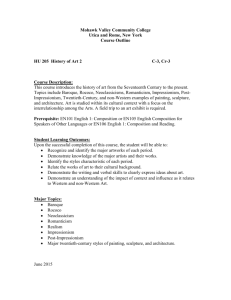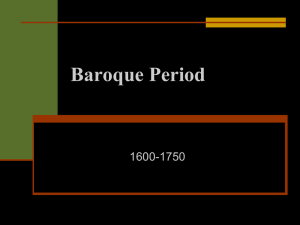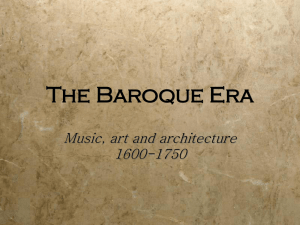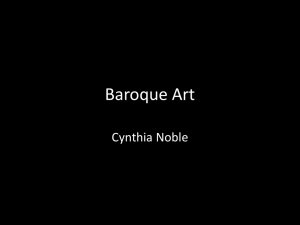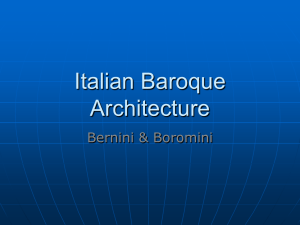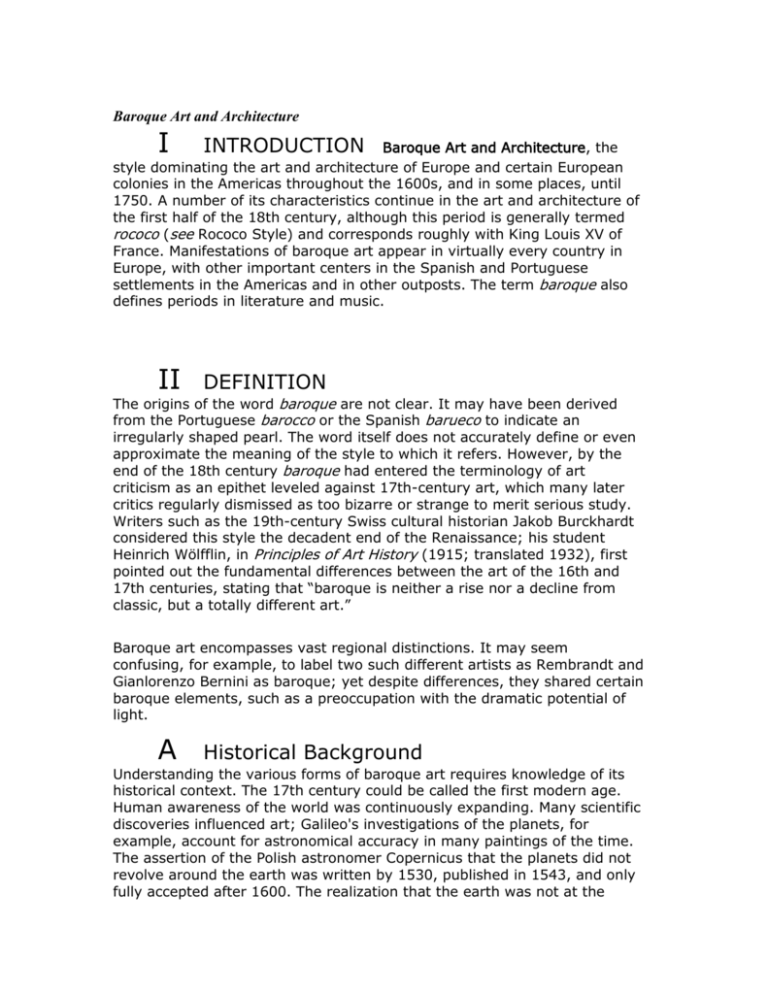
Baroque Art and Architecture
I
INTRODUCTION
II
DEFINITION
Baroque Art and Architecture, the
style dominating the art and architecture of Europe and certain European
colonies in the Americas throughout the 1600s, and in some places, until
1750. A number of its characteristics continue in the art and architecture of
the first half of the 18th century, although this period is generally termed
rococo (see Rococo Style) and corresponds roughly with King Louis XV of
France. Manifestations of baroque art appear in virtually every country in
Europe, with other important centers in the Spanish and Portuguese
settlements in the Americas and in other outposts. The term baroque also
defines periods in literature and music.
The origins of the word baroque are not clear. It may have been derived
from the Portuguese barocco or the Spanish barueco to indicate an
irregularly shaped pearl. The word itself does not accurately define or even
approximate the meaning of the style to which it refers. However, by the
end of the 18th century baroque had entered the terminology of art
criticism as an epithet leveled against 17th-century art, which many later
critics regularly dismissed as too bizarre or strange to merit serious study.
Writers such as the 19th-century Swiss cultural historian Jakob Burckhardt
considered this style the decadent end of the Renaissance; his student
Heinrich Wölfflin, in Principles of Art History (1915; translated 1932), first
pointed out the fundamental differences between the art of the 16th and
17th centuries, stating that “baroque is neither a rise nor a decline from
classic, but a totally different art.”
Baroque art encompasses vast regional distinctions. It may seem
confusing, for example, to label two such different artists as Rembrandt and
Gianlorenzo Bernini as baroque; yet despite differences, they shared certain
baroque elements, such as a preoccupation with the dramatic potential of
light.
A
Historical Background
Understanding the various forms of baroque art requires knowledge of its
historical context. The 17th century could be called the first modern age.
Human awareness of the world was continuously expanding. Many scientific
discoveries influenced art; Galileo's investigations of the planets, for
example, account for astronomical accuracy in many paintings of the time.
The assertion of the Polish astronomer Copernicus that the planets did not
revolve around the earth was written by 1530, published in 1543, and only
fully accepted after 1600. The realization that the earth was not at the
center of the universe coincided in art with the rise of pure landscape
painting devoid of human figures. The active trade and colonization policies
of many European nations accounted for numerous portrayals of places and
peoples that were exotic to Europeans.
Religion determined many aspects of baroque art. The Roman Catholic
church was a highly influential patron, and its Counter Reformation, a
movement to combat the spread of Protestantism, employed emotional,
realistic, and dramatic art as a means of propagating the faith. The
simplicity sought by Protestantism in countries such as the Netherlands and
northern Germany likewise explains the severity of the architectural styles
in those areas.
Political situations also influenced art. The absolute monarchies of France
and Spain prompted the creation of works that reflected in their size and
splendor the majesty of their kings, Louis XIV and Philip IV.
B
Baroque characteristics
C
Early baroque styles
Among the general characteristics of baroque art is a sense of movement,
energy, and tension (whether real or implied). Strong contrasts of light and
shadow enhance the dramatic effects of many paintings and sculptures.
Even baroque buildings, with their undulating walls and decorative surface
elements, imply motion. Intense spirituality is often present in works of
baroque art; in the Roman Catholic countries, for example, scenes of
ecstasies, martyrdoms, or miraculous apparitions are common. Infinite
space is often suggested in baroque paintings or sculptures; throughout the
Renaissance and into the baroque period, painters sought a grander sense
of space and truer depiction of perspective in their works. Realism is
another integral feature of baroque art; the figures in paintings are not
types but individuals with their own personalities. Artists of this time were
concerned with the inner workings of the mind and attempted to portray
the passions of the soul on the faces they painted and sculpted. The
intensity and immediacy of baroque art and its individualism and detail—
observed in such things as the convincing rendering of cloth and skin
textures—make it one of the most compelling periods of Western art.
The roots of baroque styles are found in the art of Italy, and especially in
that of Rome in the late 16th century. A desire for greater clarity and
simplification inspired a number of artists in their reaction against the
anticlassical Mannerist style, with its subjective emphasis on distortion,
asymmetry, bizarre juxtapositions, and biting colors. Annibale Carracci and
Michelangelo Merisi, called Caravaggio, were the two artists in the forefront
of the early baroque. Caravaggio's art is influenced by naturalism and the
grand humanism of Michelangelo and the High Renaissance. His paintings
often include types drawn from everyday life engaged in completely
believable activities, as well as heroic and tender depictions of religious and
mythological subjects. The school that developed around Carracci, on the
other hand, attempted to rid art of its mannered complications by returning
to the High Renaissance principles of clarity, monumentality, and balance.
This baroque classicism remained important throughout the century. A third
baroque style developed in Rome about 1630, the so-called high baroque;
it is generally considered the most characteristic mode of 17th-century art,
with its exuberance, emotionalism, theatricality, and unrestrained energy.
III
BAROQUE ART IN ITALY
In Italy painting, sculpture, and architecture evolved from Mannerism to an
early baroque mode. This change followed the Council of Trent's call in
1563 for art that would instruct and cultivate piety through simplicity.
A
Italian Baroque Painting
Some of the first and most influential artists to undertake a systematic
reform of the Mannerist style were of the Carracci family. Annibale, his
brother Agostino, and their cousin Ludovico were Bolognese artists who had
an enormous impact on the art of the baroque's greatest center, Rome.
Annibale arrived there in 1595. Having already become famous for his
frescoes in Bologna, he was commissioned to execute the ceiling painting
(1597-1600) in the Galleria of Rome's Farnese Palace, his most significant
work and a key monument in the development of the classical or ideal,
baroque manner, of which Annibale was the chief initiator. This style
appealed to such artists as Guido Reni, Domenico Zampieri, called
Domenichino, and Francesco Albani, who were trained by the Carracci at
their workshop in Bologna. Other baroque classicists, such as the French
painters Nicolas Poussin and Claude Lorrain, came from abroad to work in
Rome. Also drawn to Rome was Caravaggio, who became the principal rival
of Annibale. Works such as the Calling and the Martyrdom of Saint Matthew
(1599?-1600, San Luigi dei Francesi, Rome) found sympathetic response,
and Caravaggio came to be the guiding spirit behind an entire school of
baroque naturalists. Naturalism was spread throughout Italy in the first two
decades of the 17th century by such native painters as Orazio Gentileschi
and his daughter Artemisia, Bartolomeo Manfredi, and Caracciolo, called
Battistello, and later by foreigners working in Italy, including the French
painter Valentin de Boulogne, Gerrit van Honthorst from the Netherlands,
and the Spaniard Jusepe de Ribera. Although of lesser importance in Italy
after about 1630, baroque naturalism continued to have an enormous
impact throughout the rest of the century in all parts of Europe.
Another turning point in the history of baroque painting took place in the
late 1620s. Many artists attempted to introduce greater liveliness and
drama into their works to create illusions of limitless space (illusionism).
From 1625 to 1627 Giovanni Lanfranco painted the enormous dome of the
church of Sant' Andrea della Valle in Rome with his Assumption of the
Virgin. Although this fresco was inspired by Correggio's Renaissance
ceilings in Parma, it virtually overwhelmed contemporary spectators with its
exuberant illusionistic effects and became one of the first high baroque
masterpieces. Lanfranco's work in Rome (1613-1630) and in Naples (16341646) was fundamental to the development of illusionism in Italy.
The illusionistic ceiling fresco was a particularly important medium for high
baroque painters. Pietro Berrettini, called Pietro da Cortona, developed it to
an extraordinary degree in works such as the ceiling (1633-1639) of the
gran salone of Rome's Barberini Palace. From 1676 to 1679 Giovanni
Battista Gaulli, also called Baciccio, painted Adoration of the Name of Jesus
on the ceiling of the Gesù Church in Rome. From 1691 to 1694 Andrea
Pozzo painted The Entrance of Saint Ignatius into Paradise for the ceiling of
Sant' Ignazio, Rome, with the same theatricality, drama, and emotion that
had characterized high baroque painting throughout the century.
B
Italian Baroque Sculpture
Anti-Mannerism in Italian sculpture is first seen in Saint Cecilia (1600,
Santa Cecilia in Trastevere, Rome) by Stefano Maderno. Its simple curving
lines represent a dramatic departure from the more pronounced contortions
of earlier works. It was Gianlorenzo Bernini, however, who dominated
baroque sculpture in Rome. Among his early over-life-size group sculptures,
Abduction of Proserpina (1621-1622) and Apollo and Daphne (1622-1624,
both Galleria Borghese, Rome) display his virtuosity in the handling of
marble, creating effects of realistic dramatic tension, strong light-and-dark
contrasts, and the illusion of variegated colors. His Ecstasy of Saint Theresa
(1645-1652, Cornaro Chapel, Santa Maria della Vittoria, Rome) epitomizes
the highly charged theatricality that is a hallmark of the baroque. Bernini
was the favorite artist of the popes, for whom he did highly ambitious
works in the Vatican. The huge baldachin, a pillared canopy (1624-1633),
above the high altar in Saint Peter's Church, as well as the Cathedra Petri
(Chair of Saint Peter, 1657-1666) in the apse of the church, attest in their
colossal size and precious materials (including marble and gilded bronze) to
the sumptuous splendor of Roman Catholicism. Bernini also excelled in
portraiture, as may be seen in such examples as Costanza Buonarelli
(1635?, Bargello, Florence) and Pope Innocent X (1647?, Palazzo DoriaPamphili, Rome). His only rival in this genre was the sculptor Alessandro
Algardi.
Fountains were among the principal types of baroque public monuments,
and those by Bernini are among the most outstanding examples. Fountain
of the Four Rivers (1648-1651) in Rome's Piazza Navona startles the viewer
with its mammoth statues and obelisk balanced almost precariously on
ledges from which gush dramatic cascades of water. Bernini was also an
important and influential architect; in addition to the vast colonnade (begun
1656) embracing Saint Peter's Square, he designed such churches as Sant'
Andrea al Quirinale (1658-1670) in Rome.
C
Italian Baroque Architecture
Among the first major architects of the early baroque was Carlo Maderno,
who is known principally for his work on Saint Peter's. Between 1606 and
1612 he built the nave extension and facade of this structure, begun
approximately 100 years earlier by Donato Bramante. Aside from Bernini,
the major architects of the Roman baroque were Francesco Borromini and,
to a lesser extent, Carlo Rainaldi. Together they designed Sant' Agnese
(begun 1652) in Piazza Navona. The elegantly undulating facade of
Borromini's San Carlo alle Quattro Fontane (1665-1667) in Rome, with its
convex and concave rhythms echoing those of the interior, might be called
the quintessence of Italian baroque architecture.
Building activity also occurred in centers outside Rome during the early
decades of the 17th century. Francesco Maria Ricchino, in Milan, and
Baldassare Longhena, in Venice, both designed central-plan churches.
Longhena's Santa Maria della Salute (begun 1631) has been noted for its
extravagantly ornate exterior and its superb site at the entrance to the
Grand Canal. Especially theatrical is the work of Guarino Guarini in Turin.
His Cappella della Santa Sindone (Chapel of the Holy Shroud, 1667-94)
astounds the observer with its intricate geometric forms derived from
Islamic buildings in the unusually high dome.
IV
BAROQUE ART IN SPAIN
A
Spanish Baroque Painting
Although he is
acknowledged as one of the great Spanish painters, the influence of El
Greco's Mannerism was fairly slight in Spain. The early appearance of a
naturalistic baroque style was due to an influence from Italy.
Vincente Carducho, a Florentine artist, was influential in establishing a
Counter Reformation anti-Mannerist painting style in central Spain. Juan
Sanchez Cotan and Juan van der Hamen were both expert at painting
realistic still lifes that combine an influence from the Netherlands with that
of Caravaggio. In Valencia, a naturalistic baroque mode is observed in the
work of Francisco Ribalta, inspired by the art of both the Italian High
Renaissance painter Titian and Jusepe de Ribera. Seville and Madrid
became the two greatest centers of Spanish baroque art. For example,
early in the 17th century, baroque characteristics emerged in the paintings
of Juan de las Roelas, Francisco Pacheco, and Francisco de Herrera the
Elder. In his early work, Francisco de Zurbarán, who settled in Seville in
1629, derived some of his inspiration from Flemish prints, but his most
impressive baroque compositions are deeply moving for their direct and
realistic approach to religious subject matter. Zurbarán worked almost
exclusively for convents and monasteries. Late in his life his style was
touched by the softening influence of Bartolomé Esteban Murillo.
Works by Caravaggio were seen in Seville by 1603. Their popularity
partially accounts for the strong realist influence on the work of Spain's
greatest baroque painter, Diego de Velázquez. In Seville Velázquez painted
such earthy works as Old Woman Frying Eggs (1618, National Gallery of
Scotland, Edinburgh). In 1623 he moved to Madrid to serve as portraitist
to Philip IV, a post he retained throughout his life. His series of royal
portraits culminated in The Maids of Honor (1656, Prado, Madrid),
representing the royal family, court functionaries, and the artist himself.
Velázquez was also noted for historical and mythological compositions and
for his work as an architect and decorator.
Two other important artists of Velázquez's generation were also from
Andalucía—Alonso Cano and Murillo. Cano (also a sculptor and architect) is
noted for his sensitive renderings of flesh, as in the Descent into Limbo
(1650?, Los Angeles County Museum of Art), one of the few Spanish
baroque treatments of the nude. Murillo specialized in sentimental genre
paintings and renderings of the Immaculate Conception. The late baroque
in Seville is best represented by Juan de Valdés Leal, whose two paintings
(1672) of vanitas (reminders of mortality) subjects in the Hospital of La
Caridad, Seville, are horrifying in their morbid, ultrarealistic depictions of
skeletons and putrefying cadavers. In Madrid, the last generation of
baroque painters includes Francisco Rizi, Juan Carreño de Miranda, and
Claudio Coello, artists who cultivated a style based on the Italian high
baroque.
B
Spanish Baroque Sculpture
C
Spanish Baroque Architecture
Italian art had little
impact on Spanish baroque sculpture, which was essentially an outgrowth
of the medieval woodcarving tradition. Realism and intense attention to
detail characterize all Spanish wood sculpture; it is usually polychromed,
and, at times, provided with glass eyes, hair, and garments. Among the
most important works of Spanish baroque sculpture are numerous carved
wood retables (altar pieces), many of considerable size and richness,
produced by sculptor-architects. Of these, Gregorio Fernández, who worked
principally in Valladolid, was the major sculptor of central Spain, while the
southern school is best represented by Juan Martínez Montañés and Juan
de Mesa from Seville and Pedro de Mena and Alonso Cano working in
Granada.
Spanish
architecture of the early baroque often continues the pattern of the muted
severe style of the monastery-palace of El Escorial (1563-1582) near
Madrid, as in the Buen Retiro Palace (begun 1631, now destroyed) in
Madrid. Cano's facade for Granada Cathedral (designed 1667) contains
classical elements but, in its surface decoration, points the way to the
development of the rococo style. The most ornate baroque buildings are
found in Andalucía. Seville's Hospital of Los Venerables Sacerdotes (16871697), designed by Leonardo de Figueroa, is typical. In the rest of the
country the Churrigueresque style, a wildly exuberant baroque mode
named for the Churriguera family of architects, is evident in richly adorned
buildings in Barcelona, Madrid, and especially Salamanca.
D
Spanish Baroque in the New World
V
BAROQUE ART IN NORTHERN EUROPE
A
Flemish Baroque
The art of
the New World in the 17th century followed lines similar to that of the
Iberian countries. Among the major centers in Spanish America were
Mexico, Guatemala (especially the city of Antigua Guatemala), and Peru
(Cusco and Lima). The art of Brazil followed the patterns set by Portugal. In
painting, the styles of Caravaggio, Zurbarán, and Murillo had tremendous
impact. Paintings of the Cusco school combined indigenous decorative
forms with European-like figures. Sculptural decoration from native sources
also served as an integral part of the interiors and exteriors of the hundreds
of baroque churches constructed in a flamboyant and exaggerated
Churrigueresque mode, in all parts of the Spanish colonies at this time.
The
baroque spread rapidly to the countries of northern Europe from Italy,
where most of the major masters went to study the manifestations of the
new style. Each country, however, developed distinctive versions of the
baroque, depending on its particular political, religious, and economic
conditions.
The Flemish baroque is dominated by the brilliance of Peter Paul Rubens.
His youthful painting style was formed from such diverse Italian sources as
Caravaggio, the Carracci, and Michelangelo, evidenced by his Rape of the
Daughters of Leucippus (1616-1617?, Alte Pinakothek, Munich). Rubens
and his atelier executed a large number of mythological and religious
paintings for patrons all over Europe. Rubens's mature style, with its
exceedingly rich colors, dynamic compositions, and voluptuous female
forms, is the peak of northern baroque painting and is exemplified by his
famous series of 21 huge canvases, The Life of Marie de Médicis (16211625, Louvre, Paris). Among Rubens's pupils, his most worthy successor
was Anthony van Dyck, whose specialty was elegant portraiture, such as
Portrait of Charles I in Hunting Dress (1635, Louvre). Jacob Jordaens and
Adriaen Brouwer are best known for their convincing peasant genre scenes,
which are also the subjects of Flemish artist David Teniers and Dutch artist
Adriaen van Ostade.
Flemish baroque sculptors often derived inspiration from Italian art.
François Duquesnoy worked with Bernini in Rome, executing the gigantic
Saint Andrew in Saint Peter's in 1633. The style of the work of Artus
Quellinus was derived from Italy and from Rubens. Italian taste is equally
present in architecture, as in the former Jesuit church of Saint Charles
Borromeo (1615-1621, now a museum), in Antwerp, Belgium.
B
Dutch Baroque
At the turn of the 17th century many Dutch artists, such as Hendrik
Goltzius, were still working in the Mannerist idiom. Caraveggesque baroque
was brought to the Netherlands when several artists, including Gerrit van
Honthorst and Hendrik Terbrugghen, returned to their homeland from
Italy; by the 1620s naturalism was entrenched in Utrecht. In that decade
and the next Frans Hals produced portraits remarkable for their deft
brushwork, informality, and naturalness. Many of Hals's paintings are of
local militia companies, as is The Night Watch (1642, Rijksmuseum,
Amsterdam) by the greatest Dutch baroque master, Rembrandt. Unlike
most Dutch artists, Rembrandt painted a wide variety of subjects—
portraiture, history, mythology, religious scenes, and landscape—with
unmatched virtuosity. His handling of glowing light against dark
backgrounds, his deft, flickering brushwork in thick paint, his truthful but
sympathetic rendering of his subjects are among the virtues that place
Rembrandt in the highest rank of painters. His fame as a graphic artist is
also unsurpassed. The creation of a convincing psychological ambience and
masterly evocation of shimmering light effects distinguish the midcentury
work of Jan Vermeer; his meticulous draftsmanship and delicate handling of
pigment, often imitated, are unique. Landscape, still life, animal painting,
and architectural views now became important genres in Dutch baroque
painting.
Until about 1650, Dutch sculpture remained Mannerist; a strongly baroque
exuberance was then introduced by Flemish sculptors, most notably by
Quellinus with his work for the interior and exterior of the Amsterdam Town
Hall. The building, now the Royal Palace, was begun in 1648 to the plans of
Jacob van Campen. It epitomizes the pervasive taste of the time for a
classicism based on the published designs of the 16th-century Italian
architect Andrea Palladio.
C
English Baroque
D
French Baroque
Baroque painting in England was
dominated by the presence of Rubens and van Dyck, who inspired an entire
generation of portraitists. British sculpture was influenced equally by Italian
and Flemish styles. The architect Inigo Jones studied the classicism of
Andrea Palladio in Italy, as is evident in his Banqueting House (1619-1622,
London), with a spectacular ceiling painting, Allegory of Peace and War
(1629), by Rubens. Sir Christopher Wren also journeyed to Italy, and his
plans for Saint Paul's Cathedral (begun 1675, London) reveal his study of
Bramante, Borromini, and other Italian architects. Wren, who was in charge
of the rebuilding of London after the fire of 1666, influenced the course of
architecture in England and its North American colonies for over a century.
At the start of the 17th century in France, the Mannerist school of
Fontainebleau was still active in commissions for the Palace of
Fontainebleau, where projects such as the decoration of the Chapel of
Trinity with paintings (1619) by Martin Fréminet continued earlier
traditions. Mannerism is also found in the prints of Jacques Callot and
Jacques Bellange. The candlelit scenes of Georges de La Tour, however,
suggest Caravaggio's influence. Baroque naturalism arrived with artists
such as Valentin de Boulogne, who had lived in Italy and with those who
had contact with Flemish realism, such as the Le Nain brothers and Philippe
de Champaigne. Of greatest importance for the history of French baroque
painting is the classicism of Nicolas Poussin. Although he lived for most of
his creative life in Rome, Poussin's impact—and that of his fellow expatriate
Claude Lorrain—in his own land was enormous. Late in the century
classicism combined with a high baroque manner in Charles Lebrun's
frescoes at the Palace of Versailles. In the late baroque paintings of Antoine
Coypel, the pervasive influence of Rubens is strongly apparent, especially in
those for the Royal Chapel of Versailles.
The sculpture of Pierre Puget is also in the high baroque style; François
Girardon and Antoine Coysevox expressed a marked classicism in
monumental sculptures for the king. Girardon's group Apollo and the
Nymphs (1666-1672), in the Grotto of Thetis at Versailles, is indicative of
the French taste for a chaste version of the antique.
The Palace of Versailles (begun 1669), created for Louis XIV—the Sun
King—by Louis Le Vau, André Le Nôtre, and Charles Lebrun, is the single
most important French baroque architectural monument. It is dedicated to
the Sun King, and its measured classical forms, vast and complex gardens,
and sumptuous interiors glorify the power of the monarchy; it gave rise to
imitations by dozens of other rulers throughout Europe. A similarly
grandiose project was the enlargement (1660s-1670s) of the Louvre by Le
Vau, Lebrun, Claude Perrault, and others, a work of great restraint and
subtlety.
E
Austrian and German Baroque
Although political events—the Thirty Years' War (1618-1648) in Germany
and the Turkish presence in Austria—prevented baroque art in those
countries from truly flourishing until the 18th century, some 17th-century
artists of merit did emerge. Two masters of German baroque painting are
Adam Elsheimer, who moved to Rome in 1600, worked in a classical
manner and was strongly influenced by Italian painters, and Johann Liss,
who traveled to Venice in 1621 and worked there and in Rome.
Sculpture in 17th-century Germany and Austria retained a late Gothic or
Mannerist quality in the 17th century. In Germany the Überlingen altar
(1613-1619) by Jörg Zürn represents the continuity of the alpine
woodcarving tradition. The altar (1623?) at the Insterburg Lutheran parish
church, by Ludwig Munstermann, epitomizes the Mannerist influence.
Balthasar Permoser, a Bavarian, assimilated high baroque styles in Italy
and brought them to Dresden, where he became its leading baroque
sculptor. His festive sculptures for the Zwinger Pavilion (begun 1711), the
Dresden Palace's grandiose extension by Matthäus Pöppelman, account for
much of the structure's beauty. In Vienna, as in Dresden, baroque
architecture found favor with the ruling court on a spectacular scale. One of
Austria's greatest baroque architects, Johann Bernhard Fischer von Erlach,
demonstrated his understanding of Italian forms in his masterpiece, the
opulent Karlskirche (1716-1737) in Vienna.
Contributed By:
Edward J. Sullivan
1
1"Baroque Art and Architecture."Microsoft® Encarta® Encyclopedia 2001. © 19932000 Microsoft Corporation. All rights reserved.





